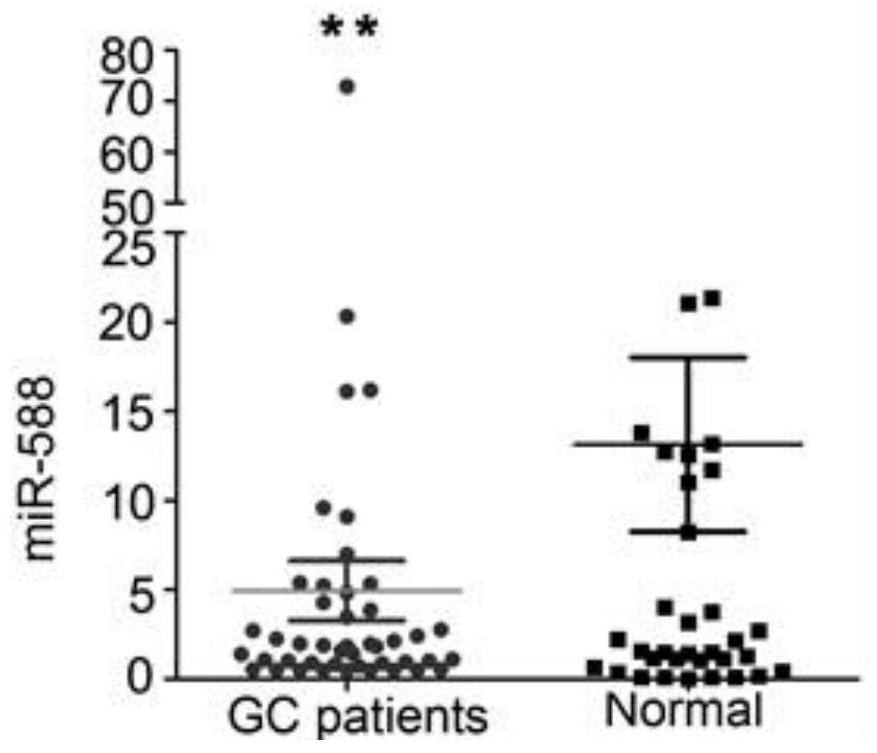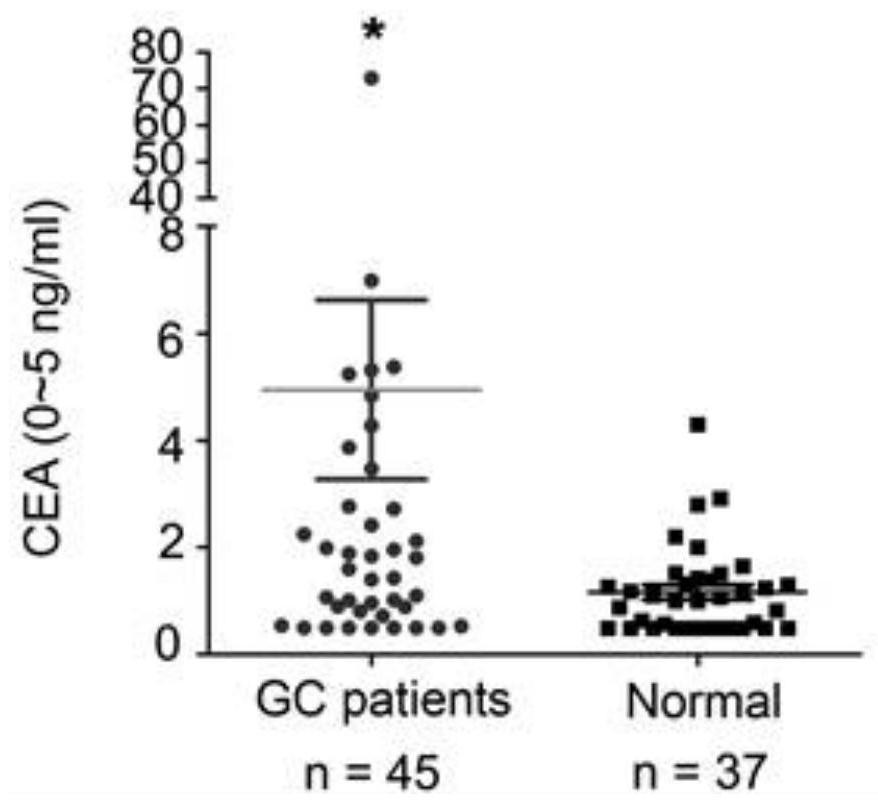Application of miR-588 and target gene thereof in gastric cancer
A technology of mir-588, 1.mir-588, applied in the field of application of miR-588 and its target genes in gastric cancer, can solve the problems of gastric cancer diagnosis, unclear prognosis assessment, and unclear role of miR-588, and achieve Good sensitivity and specificity effect
- Summary
- Abstract
- Description
- Claims
- Application Information
AI Technical Summary
Problems solved by technology
Method used
Image
Examples
Embodiment 1
[0067] Example 1: Statistical analysis of miR-588 as a diagnostic molecular marker for gastric cancer
[0068] 1. Comparison and statistical analysis of serum miR-588 expression in patients with gastric cancer and healthy people
[0069] Taking the above-mentioned serum of gastric cancer patients and healthy people as objects, real-time fluorescent quantitative PCR was carried out according to the following method to detect the expression level of serum miR-588 (U6 gene was used as an internal control) in gastric cancer patients and healthy people, and through the scatter diagram to analyze and compare.
[0070] Real-time fluorescent quantitative PCR method:
[0071] Using total RNA as a template for reverse transcription, microRNA is reverse-transcribed into cDNA using specific primers with a stem-loop structure. The product cDNA of RT is detected by quantitative PCR using the TaqMan probe method, and PCR amplification adopts specific pre-primers and universal post-primers ...
Embodiment 2
[0091] Example 2: Prediction and verification of target genes regulated by miR-588
[0092] In order to explore the mechanism of regulation of gastric cancer cells by miR-588 (sequence shown in SEQ ID NO: 1) and find its downstream key target genes, we used the miRWalk database to find thousands of potential target genes. After analysis, we screened CXCL5 (NCBI ID: 6374), CXCL9 (NCBI ID: 4283) and CXCL10 (NCBI ID: 3627) genes. Further, it was also found that: miR-588 directly binds to CXCL5 at the 1171-1177bp site, such as Figure 2A shown; miR-588 directly binds to CXCL9 at the 344-350bp and 914-920bp sites, such as Figure 2B shown. We speculate that miR-588 reduces the viability of gastric cancer cells by interacting with CXCL5, CXCL9 and CXCL10.
[0093] In order to verify the above prediction for the target gene of miR-588, the following experiments were carried out:
[0094] 1. The expression levels of CXCL5, CXCL9 and CXCL10 in gastric tumor tissues and correspondin...
Embodiment 3
[0136] Example 3: Animal experiments confirm that miR-588 is significantly related to the proliferation of gastric cancer cells in vivo
[0137] Six-week-old nude mice (n=15) were purchased from SLAC Experimental Animal Co., Ltd. (Shanghai, China), and were randomly divided into three groups (n=5 in each group): SGC-7901 cells (1×10 7 cells / mL, control group), SGC-7901 cells infected with lentiviral vector (1×10 7 cells / mL, vector group) and SGC-7901 cells infected with miR-588 lentivirus (1×10 7 cells / mL, miR-588 overexpression group), subcutaneously injected into the back of each nude mouse (0.2 mL). Average tumor volumes were measured three times per week. At the end of the experiment (day 35), mice were sacrificed and tumors were excised for volume measurement.
[0138] Figure 4A The photos of the final tumor tissues of mice in each group are given, Figure 4B The data of tumor volume in mice measured every 7 days are given. Figure 4A and Figure 4B It was shown t...
PUM
 Login to View More
Login to View More Abstract
Description
Claims
Application Information
 Login to View More
Login to View More - R&D
- Intellectual Property
- Life Sciences
- Materials
- Tech Scout
- Unparalleled Data Quality
- Higher Quality Content
- 60% Fewer Hallucinations
Browse by: Latest US Patents, China's latest patents, Technical Efficacy Thesaurus, Application Domain, Technology Topic, Popular Technical Reports.
© 2025 PatSnap. All rights reserved.Legal|Privacy policy|Modern Slavery Act Transparency Statement|Sitemap|About US| Contact US: help@patsnap.com



